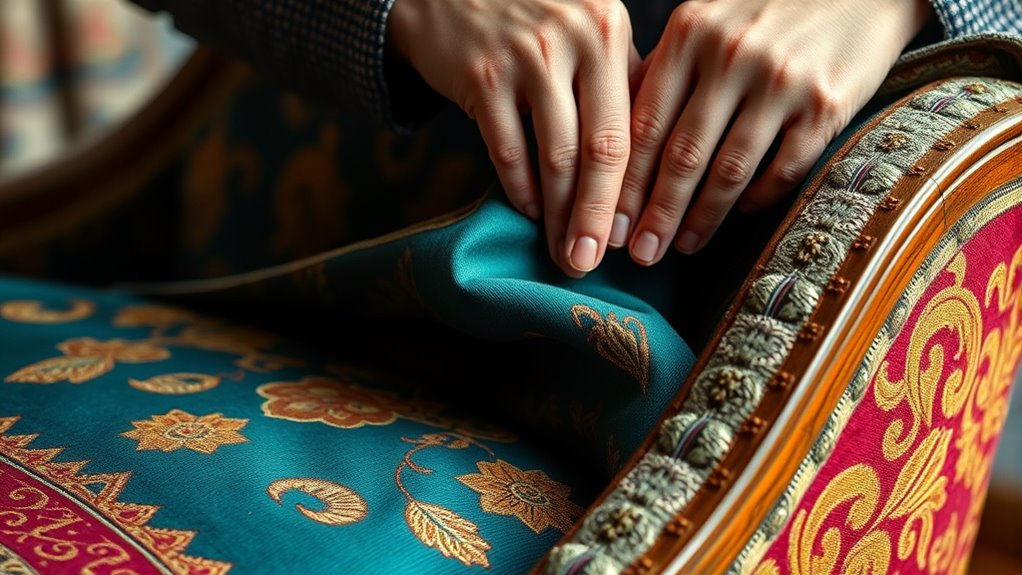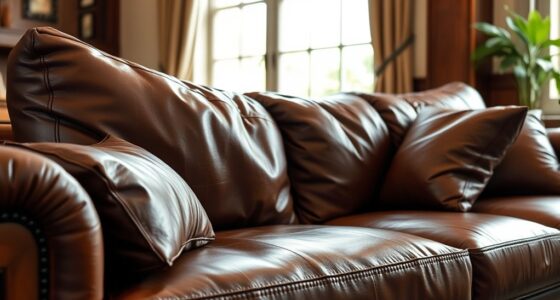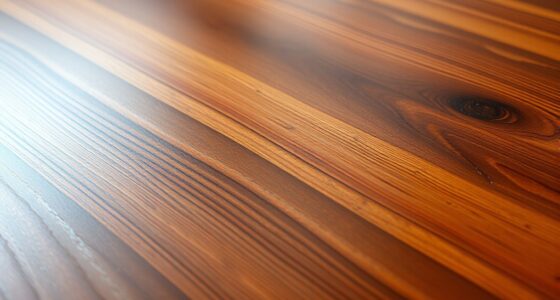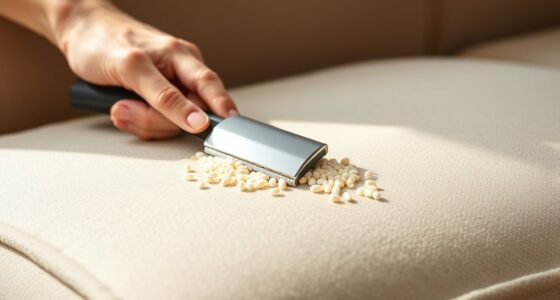Reupholstering your ottoman without sewing is straightforward if you gather the right tools like a staple gun, fabric glue, scissors, and measuring tape. Start by carefully removing the old fabric and cleaning the surface. Measure and cut your new fabric, then secure it with staples or adhesive for a smooth, professional finish. Finish with decorative nails or trim for extra style. To learn simple tips and techniques, continue exploring how to successfully reupholster without sewing.
Key Takeaways
- Use fabric glue or adhesive for a seamless, sewing-free upholstery application.
- Secure new fabric with a staple gun, starting from the center and working outward for tautness.
- Remove old fabric carefully and prepare the surface by cleaning and smoothing for better adhesion.
- Add decorative nails or trim after securing the fabric to enhance style without sewing.
- Measure accurately and cut fabric precisely to fit curves and corners without sewing.
Gathering the Necessary Tools and Materials
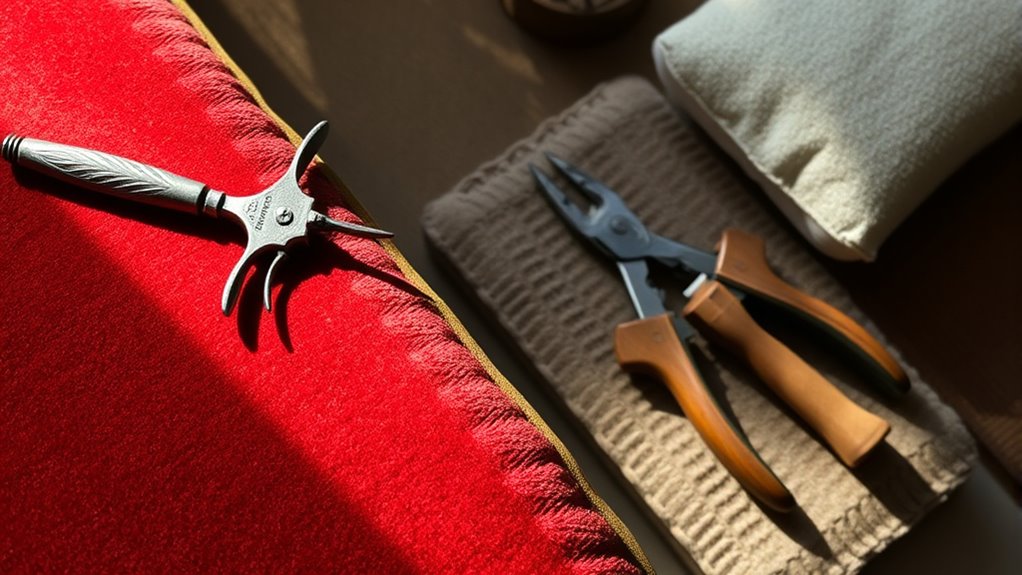
Before you begin reupholstering your Ottoman, it is vital to gather all the necessary tools and materials. Start with fabric glue, which provides a strong hold without sewing, making the process easier and cleaner. You’ll also need decorative nails to add a stylish touch to your finished piece, so keep a set handy. A staple gun, scissors, and a flathead screwdriver are essential for removing old fabric and securing new material in place. Don’t forget a measuring tape to ensure accurate cuts and placement. Having these tools ready before you start saves time and prevents interruptions. Collecting everything beforehand helps you stay organized and focused, making your reupholstery project smoother and more enjoyable.
Removing the Old Upholstery and Preparing the Surface
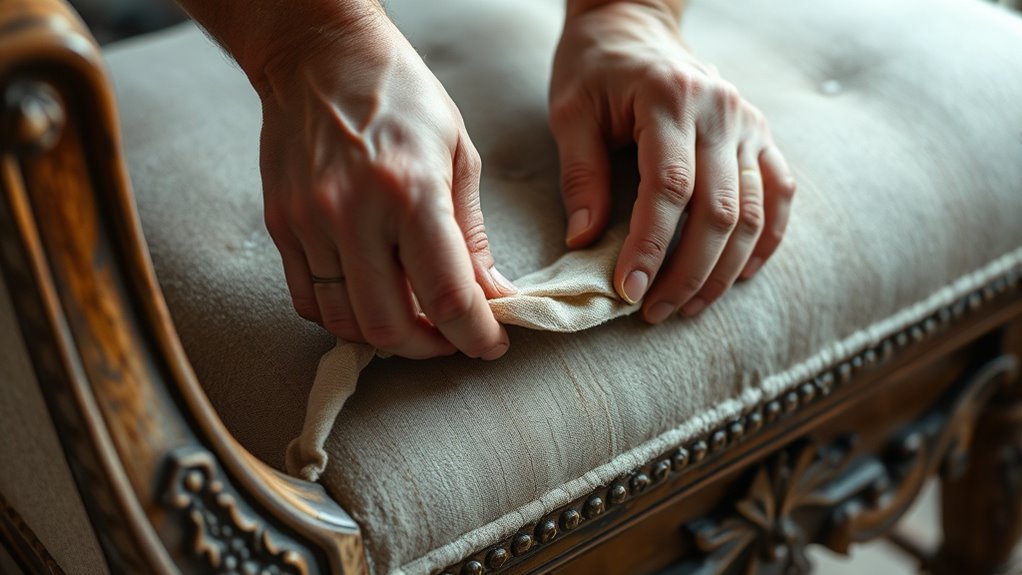
Start by carefully detaching the old fabric to avoid damaging the underlying surface. Once removed, make sure to smooth out any rough spots and clean the surface thoroughly. This prepares a clean, even base for your new upholstery work. Additionally, inspecting the surface’s material choice ensures compatibility with your new fabric and enhances durability.
Detach Old Fabric Carefully
As you begin detaching the old fabric, it’s important to handle the process carefully to avoid damaging the underlying surface. Use the right tools with caution, maintaining tool safety at all times. Gently peel away the fabric, pulling along the grain to prevent tears. Take your time—rushing can cause accidents or damage. As you remove the old upholstery, consider your fabric selection for the new cover to ensure it fits perfectly and complements your style. Be mindful of staples or tacks, removing them carefully to avoid injury. Stay focused and gentle, knowing that a careful approach results in a smooth surface ready for reupholstery. Additionally, understanding celebrity transformations can inspire confidence in tackling home projects with a fresh perspective.
- Feel the satisfaction of a clean, smooth surface
- Experience confidence with safe tool handling
- Avoid frustration caused by accidental damage
- Anticipate the joy of a fresh, new fabric
- Celebrate your progress every step of the way
Smooth and Clean Surface
Once you’ve carefully removed the old fabric, focus on cleaning and smoothing the surface to guarantee a flawless foundation for the new upholstery. Use a vacuum or brush to clear away dust, debris, and loose fibers. Check the surface for any damage or rough spots, sanding them down if necessary to achieve a smooth finish. When selecting fabric, consider durability and style to match your decor. If cushion padding is worn or uneven, replace or reshape it before upholstering. A clean, smooth surface ensures the new fabric adheres properly and looks neat. Taking the time to prepare the surface properly guarantees bumps or wrinkles, giving your ottoman a polished, professional appearance without sewing. Additionally, understanding AI in Education can inspire innovative approaches to learning DIY skills for home improvement projects.
Measuring and Cutting Your New Fabric or Covering
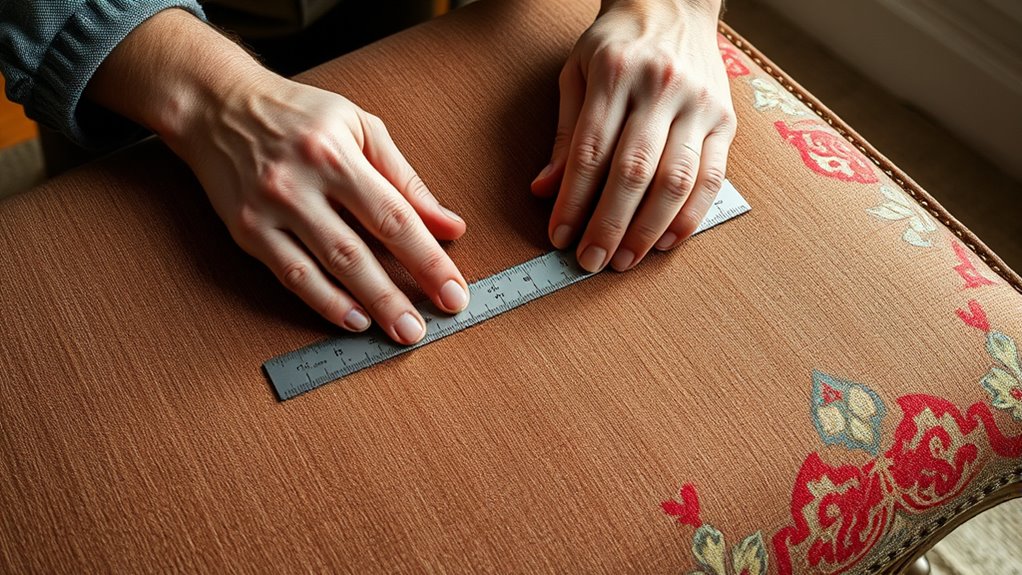
Before you begin cutting your fabric or covering, accurate measurements are essential to guarantee a perfect fit. Use reliable measurement tools like a tape measure or ruler to capture every dimension of your ottoman. Pay close attention to fabric patterns—aligning them correctly adds a polished look. Measure twice to avoid costly mistakes and ensure your fabric covers all surfaces seamlessly. Take note of any curves or corners that require extra fabric. Remember, precise measurements help you cut confidently, reducing waste and frustration. Incorporating emotional support techniques can help you stay patient and focused during this detailed process.
Securing the New Cover Without Sewing
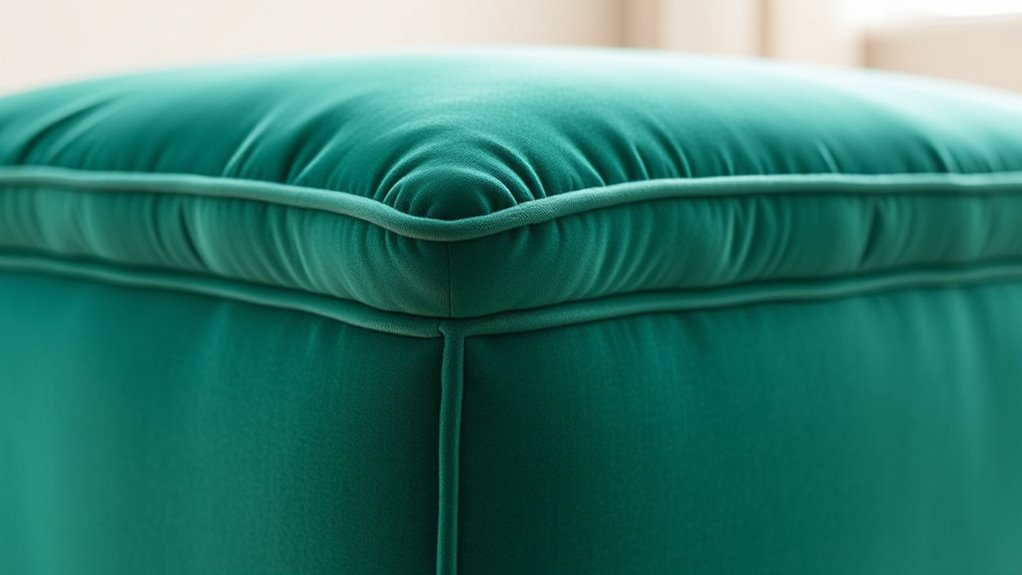
You can secure your new cover without sewing by using upholstery staples or fabric adhesive. Staples provide a quick, sturdy hold, while adhesive offers a clean, seamless finish. Both methods make reupholstering easier and less time-consuming. For a more professional look, choosing the right materials for upholstery is essential to ensure durability and a polished appearance.
Using Upholstery Staples
Using upholstery staples is a quick and effective way to secure your new fabric cover without sewing. They provide a firm hold, ensuring your cushion filling stays in place and your decorative accents remain perfectly arranged. As you staple, you’ll feel the satisfaction of transforming your ottoman effortlessly. Keep the staples close together for a smooth, professional look, and avoid puncturing the fabric. Remember to work from the center outward, gently pulling the fabric taut. This method keeps your cover snug and wrinkle-free, while still allowing easy adjustments if needed. Upholstery staples give you a clean finish without sewing, making your reupholstery process faster and more enjoyable. With this technique, your ottoman will look refreshed, stylish, and ready to enhance your space. Additionally, understanding safety precautions when using staples ensures a safer and more efficient reupholstery project.
Applying Fabric Adhesive
Applying fabric adhesive is an effective way to secure your new cover without sewing, especially when you want a seamless finish. Start by choosing the right fabric selection; lightweight, flexible fabrics work best for smooth application. Next, consider the adhesive types—contact cement, spray adhesive, or fabric glue—each suited for different projects. For a clean look, spray adhesives provide even coverage, but ensure you work in a well-ventilated area. Apply the adhesive to both the ottoman surface and the fabric, following the manufacturer’s instructions. Press the fabric onto the surface, smoothing out wrinkles as you go. Let the adhesive set fully before handling to ensure a durable, secure fit. This method offers a quick, neat alternative to sewing, giving your ottoman a fresh, polished appearance. Utilizing adhesive strength ensures the fabric remains securely attached over time.
Adding Finishing Touches for a Professional Look

To achieve a polished, professional look on your reupholstered ottoman, adding finishing touches is essential. Focus on selecting fabric patterns that complement your space and enhance visual appeal. Pay attention to color coordination to create harmony with your existing décor. Smooth out any wrinkles for a sleek finish, and consider adding decorative trim or nail-head accents for a refined touch. These details elevate your project from DIY to designer quality. Incorporating textile art techniques can also add unique texture and visual interest to your finished piece.
Tips for Maintaining and Refreshing Your Reupholstered Ottoman
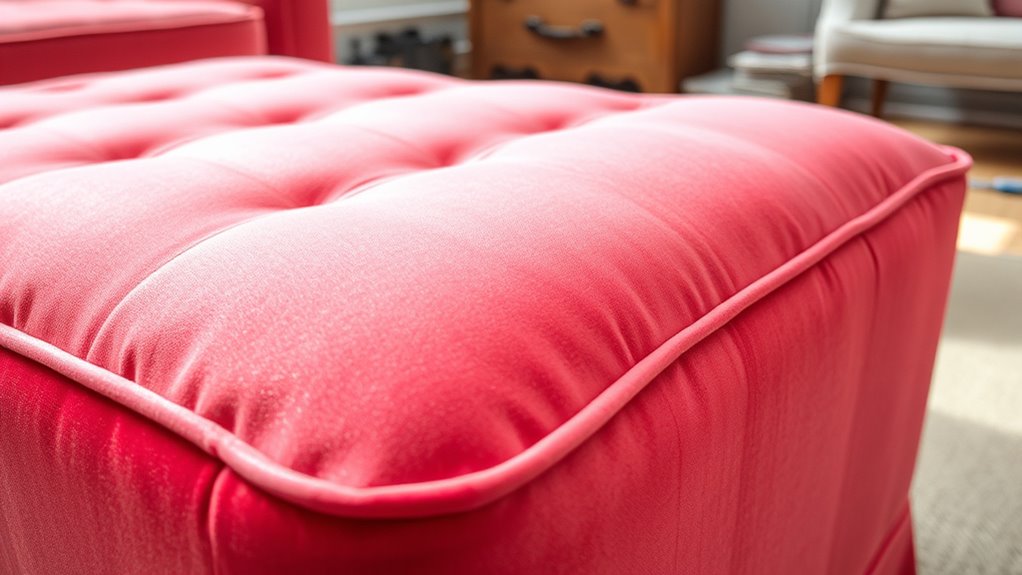
Regular maintenance is key to keeping your reupholstered ottoman looking fresh and beautiful. Start by choosing the right fabric selection that suits your lifestyle—durable and easy to clean fabrics work best. To refresh its appearance, regularly vacuum or gently brush the fabric to remove dust and dirt. Pay attention to color coordination; if you notice fading, consider using fabric-safe sprays or spot cleaning to restore vibrancy. Rotate cushions or pillows if your ottoman has any to prevent uneven wear. Keep your ottoman out of direct sunlight to avoid fading over time. When deep cleaning, use mild solutions compatible with your fabric type. Additionally, understanding self watering plant pots can help you incorporate low-maintenance decor elements that complement your furniture. Consistent care extends the life of your reupholstered piece and keeps it looking stylish and inviting.
Frequently Asked Questions
Can I Reupholster an Ottoman Without Any Prior Experience?
You can definitely reupholster an ottoman without prior experience, especially if you follow beginner tips like choosing simple projects. Use tool alternatives such as adhesive spray instead of staples or nails, which makes the process easier. Focus on removing old fabric carefully and attaching new fabric securely. Patience and attention to detail are key. With some research and the right tools, you’ll find reupholstering an ottoman doable even as a beginner.
What Alternative Tools Can I Use if I Don’T Have a Staple Gun?
Sure, if you’re out of a staple gun, don’t panic—your DIY upholstery tools can surprise you. Think about alternative fastening methods like upholstery tacks, adhesive spray, or even heavy-duty glue. These options transform your project into a creative adventure, showcasing your resourcefulness. Just imagine, turning ordinary household items into tools that hold your ottoman together—proof that sometimes, improvisation beats the staple gun every time.
How Long Does a No-Sew Reupholstery Project Typically Take?
A no-sew reupholstery project usually takes about a day or two, depending on your project timeline and material preparation. You’ll want to allocate time for gathering supplies, measuring, and cutting fabric. Since you’re avoiding sewing, focus on using alternative tools like adhesive or fabric glue. With everything ready, you can complete the project relatively quickly, often finishing within a few hours if you stay organized and work efficiently.
Is It Possible to Reupholster a Curved Ottoman Without Sewing?
Yes, you can reupholster a curved ottoman without sewing using no sew techniques. Focus on curved upholstery methods that involve adhesive fabrics or fabric tapes designed for upholstery projects. You’ll need to carefully stretch and secure the fabric around the curves, avoiding staples or sewing. With patience and the right tools, no sew techniques work well for curved upholstery, giving your ottoman a fresh look without sewing.
What Types of Fabric Are Best for No-Sew Upholstery Projects?
Did you know that fabric choice impacts durability and longevity? For no-sew upholstery projects, you should opt for fabrics that excel in fabric durability and offer colorfast options. Heavy-duty vinyl, canvas, and outdoor fabrics are excellent choices because they withstand wear and fading without sewing. These fabrics make your project easier and ensure your furniture stays vibrant and durable over time, even with frequent use.
Conclusion
Now, as you sit back and admire your freshly reupholstered ottoman, it’s funny how a simple project like this can turn a piece of furniture into a true centerpiece. With the right tools and a bit of patience, you’ve created something special—no sewing needed. Every time you glance at your ottoman, you’ll remember the satisfying moment you transformed it yourself, proving that sometimes, the best upgrades happen when you least expect them.
